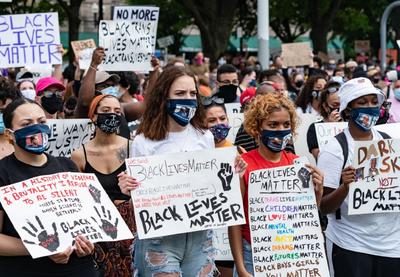To our community of educators, wherever this may find you:
This week, we on the TT staff have come to our work with a range of emotions. Some of us are feeling a strong urge to be useful but struggling to imagine what that looks like. Some of us are feeling exhausted, “sick and tired of being sick and tired,” as the great Fannie Lou Hamer once said.
Some of us have years of experience organizing in our communities, and others are new to engaging in this way. For some, anti-Blackness and police violence are deeply personal, painful lived experiences. For others, antiracism and allyship are ongoing processes of learning, unlearning and working toward a practice of humbled solidarity.
Despite these differences, we’re all feeling combinations of grief and anger, of powerlessness and resolve. And under it all, a deep, deep sadness.
Maybe you are feeling this too.
Because we believe in the value of social justice education, we want to offer practical answers. We want to give students an explanation of why things are the way they are. We want to chart a path forward for them, for you and for us.
Yet, as we witness and share in the collective mourning for lost Black lives and the demands for justice for victims like George Floyd, Breonna Taylor and Tony McDade, we must admit that we don’t have the answers.
So instead of reaching out to share a one-size-fits-all plan, we’re writing to ask you to commit to checking in with students individually. Instead of preparing an answer in advance, we hope you’ll find out what questions your students have.
What do your Black students need to feel safe and valued in their learning space right now? What do your non-Black students need to better understand how to provide support and stand against injustice? What do your students want you to know about their understanding of justice and desire to take action? What are their fears in this moment? What gives them hope?
There will be a time for takeaways. In the coming weeks and months, our questions will shift toward analysis. We’ll concretely and consistently recognize the depth of the history that informs this moment and the diverse range of lived experiences that share the streets. We’ll turn to vital questions about educational spaces and their relationship to systemic, racist violence. We’ll continue to look at our institutions and consider how they might better serve all people. We’ll continue to think critically about the role educators can play in imagining a liberatory future for all.
When we do, we’ll look back to the solidarity we’re seeing now.
In activist spaces, Black people have too long had to carry the torch. The same is true in education, where equity work too often falls disproportionately on overworked Black educators. We are heartened by the multiracial coalitions we see marching alongside each other and disheartened by white protesters who are co-opting space rather than joining in solidarity. We hope that non-Black educators will share in the work to come with self-awareness and avoid demanding their Black colleagues’ extra emotional labor.
In the days and weeks to come, we’ll continue to formulate answers to the question that motivates our work: How can we help? But we’re admitting that, right now, we don’t have all of those answers.
Instead, we want to let you know that we’re with you. We’re here and we’re listening. And we hope you’re doing the same for the students in your care.
In solidarity and with love,
Teaching Tolerance


0 COMMENTS